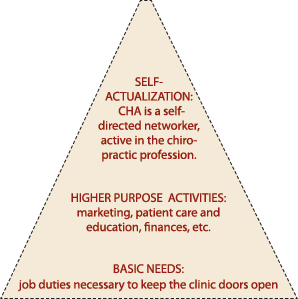
The Learning Agenda: Training and retaining the chiropractic activist
By Brandi MacDonald
Features Education ProfessionAt any given time in Canada, many chiropractic offices are being
challenged by a training dilemma in clinics. The dilemma is how to move
chiropractic health assistants from being “front-end receptionists” to
chiropractic activists in their roles, both within the clinic and the
community at large.
 |
| From left to right are Ashley Demsky, Brandi MacDonald and Lesley Camisa. Ashley and Lesley are two of MacDonald’s four chiropractic assistants.
|
At any given time in Canada, many chiropractic offices are being challenged by a training dilemma in clinics. The dilemma is how to move chiropractic health assistants from being “front-end receptionists” to chiropractic activists in their roles, both within the clinic and the community at large. As the unemployment rate hit an all-time low in November in Canada, the need for a training plan has never been more paramount than it is now. This article is designed to describe how to simplify the steps to training by setting up a system wherein they can be duplicated, and moving staff members along a continuum of growth in your clinic.
A staff training system needs to take into account the levels of mastery a chiropractic health assistant needs to accomplish prior to moving to another performance level. One can apply the philosophy of Maslow’s hierarchy, as a concept of human development and growth, to the training process. Maslow contended that humans require basic needs – food, clothing and shelter – prior to moving on to more complex sets of behaviour patterns. At the top, where the most desirable level of Maslow’s hierarchy is found, is self-actualization. This level represents people feeling fulfilled, purposeful, and enlightened. Without the base levels of the pyramid – basic needs – humans have a harder time evolving their behaviour to reach this sought-after level. This hierarchy is a concept that a staff training system can be modelled after.
 The “base” of a staff training system – or the “basic needs” of staff training – represent all the job duties in a clinic that are necessary to keep the clinic doors open. Duties may include booking patients, billing, answering the phone, basic insurance protocols, cash protocols, file management, processing patients and flow. This basic level doesn’t require the staff member to know much about chiropractic, and could in fact be filled by a temporary receptionist if the procedures are written out. This, by no means, minimizes the importance of this level, as this is the “basic needs” of training. This level of the pyramid represents the largest level with the greatest amount of training needed and level of involvement from the “trainer” to provide it. Chiropractic health assistants at this level need in-depth support, feedback, modification and reinforcement.
The “base” of a staff training system – or the “basic needs” of staff training – represent all the job duties in a clinic that are necessary to keep the clinic doors open. Duties may include booking patients, billing, answering the phone, basic insurance protocols, cash protocols, file management, processing patients and flow. This basic level doesn’t require the staff member to know much about chiropractic, and could in fact be filled by a temporary receptionist if the procedures are written out. This, by no means, minimizes the importance of this level, as this is the “basic needs” of training. This level of the pyramid represents the largest level with the greatest amount of training needed and level of involvement from the “trainer” to provide it. Chiropractic health assistants at this level need in-depth support, feedback, modification and reinforcement.
As staff begin to master the “procedures” at the “basic need” level, the next level of training can begin. This level of performance training involves higher purpose activities in the clinic. It may include things like making the staff responsible for marketing strategies, explaining the philosophy of chiropractic, participation in internal and external events, specific duties with
patients, performing objective findings, reviewing policies with patients, being responsible for finances, etc. This level of the training pyramid is still a large part of the training continuum and heavily reliant on teaching and feedback from the doctor.
Once the CHA has shown mastery on the first two levels of the pyramid, room for advancement should be considered. The CHA is probably in a position wherein they can train someone on these two levels and may be considered as a “senior” CHA or office manager/administrator. At this level, more self-governance is observable in staff members. They require less doctor-led training, and may become responsible for learning more skills on their own. At this level, they may be capable of giving “health and wellness” talks in the clinic or community. These CHAs may be holding staff training sessions for other CHAs in the clinic.
In many clinics, the training pyramid may stop at this level, and some CHAs may be content to remain here for the reminder of their time at the clinic. I challenge CHAs to one further level, which moves staff onto the “self-actualizing” part of the profession. This level requires CHAs to be completely self-directed, purposeful and active in the chiropractic profession. They can broaden their chiropractic networks with other clinics and doctors; they may mastermind with like-minded CHAs; and the philosophy and science of chiropractic becomes their mission, not just their job.
Imagine the self-actualizing power in this position for the health paradigm of the general public!
The benefit of the staff training pyramid is threefold:
1. It provides a mechanism to clearly define roles, titles, job duties and fair compensation.
2. It allows staff to continually engage in their personal learning which leads to greater retention of staff.
3. It allows the doctor to systemize training so that the “I didn’t know that” or “ I wasn’t trained properly” is a thing of the past!
The training pyramid, although heavy on involvement from the “trainer” or doctor, early on, pays off with personal growth for the CHA throughout their time in a chiropractic clinic. Personal growth and empowerment are the keys to true activism. And true activism advances chiropractic.
 Brandi MacDonald manages a multi-doctor, high-volume clinic in Edmonton and is owner of True Concepts, a service that coaches chiropractors in hiring, retaining, and inspiring staff. Along with Dr. Tom Preston, she also offers a one-year CHA coaching program. She may be reached at bj.mac@shaw.ca .
Brandi MacDonald manages a multi-doctor, high-volume clinic in Edmonton and is owner of True Concepts, a service that coaches chiropractors in hiring, retaining, and inspiring staff. Along with Dr. Tom Preston, she also offers a one-year CHA coaching program. She may be reached at bj.mac@shaw.ca .
Print this page